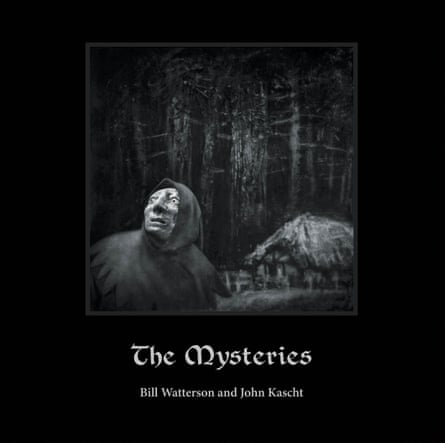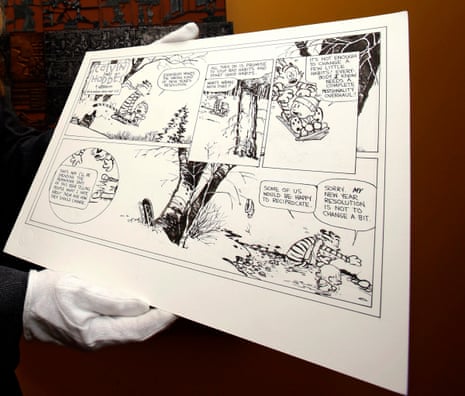On New Year’s Eve 1995, six-year-old Calvin and his tiger, Hobbes, sledded off together for the last time. It was the final strip in Bill Watterson’s acclaimed comic, Calvin and Hobbes, which appeared in 2,400 newspapers, and it looked as though it might be Watterson’s final published work.
In the ensuing decades, the man who had become a cartooning legend seemed to have all but disappeared, as if he were just a figment of Calvin’s rich imagination. He rarely gave interviews; his occasional small projects, including secretly filling in for another cartoonist for a few days, were newsworthy events. Last week’s announcement of Watterson’s first major work in nearly 30 years – The Mysteries, a vibrantly illustrated “fable for grown-ups” – stunned fans and called for celebration.
“This is pretty exciting and monumental that he’s releasing a whole book,” says Nevin Martell of Washington DC, a lifelong reader and the author of Looking for Calvin and Hobbes, a story of the strip and Watterson that’s also part memoir. “I’m surprised and yet not surprised – surprised in the sense that he’s putting something out, not surprised that since he is putting something out, it’s so wildly different from what he did on Calvin and Hobbes.”

After years avoiding the public eye, what prompted Watterson to come out of retirement? “He’s been working creatively, painting and doing other types of art, since he ended the strip,” says Jenny Robb, head curator of comics at Ohio State University’s Billy Ireland Cartoon Library and Museum, which houses most of Watterson’s original strips. “From that standpoint, it makes sense that eventually he would find a project that he wanted to share with his audience.”
Though Watterson has been described as reclusive, that might not be the best word; he lives a normal life, says Robb, one of the few people to have interviewed him, but “he doesn’t like to be in the spotlight. He wants to let his artwork speak for itself. And he’s uncomfortable in the role of a spokesperson for comics – he would prefer that people read and experience the comic strip rather than engaging with it filtered through him talking about it.”
And many millions of people have. According to the publisher, Andrews McMeel, Calvin and Hobbes books have sold 50m copies, and the full collection has the unusual honor of having been the heaviest book to reach the New York Times bestseller list (not to mention the most expensive). Since the strip began in 1985, readers have embraced the adventures of the impulsive Calvin, often lost in a vivid internal world; his thoughtful tiger, Hobbes, who is real to him but stuffed to everyone else; his longsuffering parents; his babysitter and arch-nemesis, Rosalyn; and his bright and diligent fellow first-grader Susie, target of many a failed snowball throw.

“It has everything that can make a comic strip successful,” says Robb. “It’s funny, first of all. It’s insightful. It’s wise. It’s visually appealing,” particularly in the groundbreaking Sunday strips, which eventually shed the grid layout in favor of panels of various shapes and sizes to suit the story. “You see him really stretching as an artist in the Sundays and they’re just beautiful to look at,” Robb says. “So he brings together all the different aspects of a comic strip, the writing, the characters, the layout, the artwork, and he just has a mastery of all of those.”
Robb and Martell both point to another of the strip’s most potent qualities: timelessness.
“Even though we live in a very digital age now, with all sorts of devices and all sorts of connectivity that didn’t exist when Calvin and Hobbes was in print, when you go back and read those strips, it’s essentially a story of a boy and his best friend and the adventures that they went on,” Martell says. “It’s not a strip that’s clouded by pop culture references or other types of references that feel really dated. It feels like it exists in a place out of time. And that’s why kids today who are lucky enough to either be given a book or just stumble upon it in the library, when they pick up those strips, they make just as much sense today as when they were first released.” He calls the strip “one of the greatest works of popular culture of the 20th century”.
If the storylines are timeless, so are the strip’s weightier themes. Watterson uses Calvin and Hobbes, best friends with opposing personalities, to explore the ups and downs of childhood; mortality, as when Calvin tries, and fails, to nurse an injured raccoon back to health; environmental fears (“Sometimes I think the surest sign that intelligent life exists elsewhere in the universe is that none of it has tried to contact us,” Calvin says); horse-race politics, as Calvin reports on his father’s approval rating with polls of “household six-year-olds”; consumerism (“Hey Mom, I saw a bunch of products on TV that I didn’t know existed, but I desperately need!”); and much more.
“I think it demonstrated what was possible with the comics art form, how you can tell stories that appeal to a wide audience with visual variety,” Robb says. “These are all things that had been done before. But Calvin and Hobbes brought a lot of unique features together and showed how you could create something really special and really magical.”
As for the next chapter in Watterson’s career, Andrews McMeel describes The Mysteries as “a compelling, provocative story that invites readers to examine their place in the universe and their responsibility to others and the planet we all share”, calling it “a fable that dares to intimate the big questions about our place in the universe”.
The book is a collaboration between Watterson and the celebrated caricaturist John Kascht, and it appears far bleaker than either illustrator’s earlier work. The few published panels are sombre and foreboding, presented in shades of gray. “The style of the writing, the style of the art is intensely different from Calvin and Hobbes. And I think that’s a very conscious decision on [Watterson’s] part. He would not ever want to be pigeonholed as just the Calvin and Hobbes guy,” Martell says.
“The artwork is very different from both [Watterson’s and Kascht’s] styles,” says Robb. “So I’m really curious to know how they collaborated on that and how that worked. Because it doesn’t really look like John and doesn’t really look like Bill to me.”
For all the darkness, the characters in the new book – sad-eyed knights, self-satisfied kings and pensive wizards – still possess the vitality that made a boy and his tiger seem to exist beyond the page. Yet the pair never appeared anywhere else: Watterson was firmly against licensing his strip, which is why there is no Spaceman Spiff: The Movie, no authorized Calvinball league or official line of Hobbes-endorsed red wagons. (Calvin himself would surely be unhappy with his creator’s decision to forgo millions of dollars; Hobbes, who prefers the simple life – a tuna sandwich and a snooze in a sunbeam – would approve.)
Kirsty Melville, president of Andrews McMeel, publisher of the new book as well as Calvin and Hobbes, wasn’t prepared to reveal much else about the new volume. But, she said of Watterson: “Someone who can create the brilliance of Calvin and Hobbes – who knows what else is lurking in there?”
